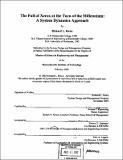| dc.contributor.advisor | Nelson R. Repenning. | en_US |
| dc.contributor.author | Howe, Richard L. (Richard Leighton), 1965- | en_US |
| dc.contributor.other | System Design and Management Program. | en_US |
| dc.date.accessioned | 2005-09-27T21:03:59Z | |
| dc.date.available | 2005-09-27T21:03:59Z | |
| dc.date.copyright | 2002 | en_US |
| dc.date.issued | 2002 | en_US |
| dc.identifier.uri | http://hdl.handle.net/1721.1/29176 | |
| dc.description | Thesis (S.M.)--Massachusetts Institute of Technology, System Design & Management Program, 2002. | en_US |
| dc.description | Includes bibliographical references. | en_US |
| dc.description.abstract | This thesis studies some aspects of the business performance collapse of Xerox Corporation towards the end of the 1990s and the beginning of the 21" century. Utilizing the field of system dynamics as the primary modeling and analysis tool, the thesis specifically looks at three interrelated factors that an extensive public literature search, and the author's own personal experience as a Xerox employee, showed were of central importance in Xerox' decline. These factors, and their effects, were the following. First, Xerox reorganized and consolidated its U.S. customer administration centers (CACs) from approximately three-dozen geographically distributed locations to a small handful of centralized locations. This left customers with new and unfamiliar administrative staff who were more prone to making billing errors and were less efficient in fixing them once they were discovered, thereby beginning the process of alienating customers and also forcing the sales staff to spend less time selling as they tried to fix the billing errors. Secondly, Xerox realigned and reorganized its direct sales force from a geographic structure to one based on specific industries. This broke tremendous numbers of customer/sales representative relationships, thereby further alienating customers, since many sales reps either left Xerox (due primarily to the turmoil within Xerox) or, if they stayed, they had their territories changed. This also resulted in sales reps spending less time selling, both in the short term (due to increased new hire training, industry realignment training, and "FUD factor" chum) and in the long term (due to increased travel time). Thirdly, especially relative to its competition, Xerox' product line began to lose appeal in the marketplace. Ultimately, however, my analysis shows that the almost simultaneous confluence of these three factors had a nonlinear effect on Xerox' business - an effect that was worse than the sum of the three individual factors had they each occurred alone. And, since the time constants involved in these dynamics and in the overall system that is the document processing market are in many cases on the order of years, the effects on Xerox' business were significantly longer than the duration of the causal factors themselves. | en_US |
| dc.description.statementofresponsibility | by Richard L. Howe. | en_US |
| dc.format.extent | 179 p. | en_US |
| dc.format.extent | 16626027 bytes | |
| dc.format.extent | 16625781 bytes | |
| dc.format.mimetype | application/pdf | |
| dc.format.mimetype | application/pdf | |
| dc.language.iso | eng | en_US |
| dc.publisher | Massachusetts Institute of Technology | en_US |
| dc.rights | M.I.T. theses are protected by copyright. They may be viewed from this source for any purpose, but reproduction or distribution in any format is prohibited without written permission. See provided URL for inquiries about permission. | en_US |
| dc.rights.uri | http://dspace.mit.edu/handle/1721.1/7582 | |
| dc.subject | System Design and Management Program. | en_US |
| dc.title | The fall of Xerox at the turn of the millennium : a system dynamics approach | en_US |
| dc.type | Thesis | en_US |
| dc.description.degree | S.M. | en_US |
| dc.contributor.department | System Design and Management Program. | en_US |
| dc.identifier.oclc | 50952162 | en_US |
